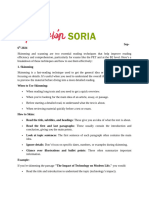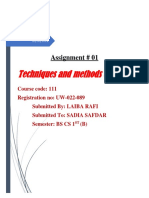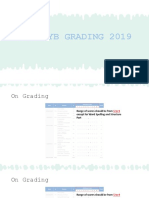Reading Comprehension Strategy: Skimming and Scanning
Reading Comprehension Strategy: Skimming and Scanning
Uploaded by
Mr. TaqwaCopyright:
Available Formats
Reading Comprehension Strategy: Skimming and Scanning
Reading Comprehension Strategy: Skimming and Scanning
Uploaded by
Mr. TaqwaOriginal Title
Copyright
Available Formats
Share this document
Did you find this document useful?
Is this content inappropriate?
Copyright:
Available Formats
Reading Comprehension Strategy: Skimming and Scanning
Reading Comprehension Strategy: Skimming and Scanning
Uploaded by
Mr. TaqwaCopyright:
Available Formats
Skimming and Scanning
Reading Comprehension Strategy
Skimming and Scanning are rapid reading strategies that can be used to glance at a text looking for particular information,
particularly in large bodies of information when it is unnecessary to retain all of it.
Skimming is used to get the most important information or the gist of a text. When skimming, we read the entire text and take
note of different components such as headings, pictures and charts. However, it is not essential to understand every word to
understand the overall meaning of a text. We use skimming strategies when quickly skim-reading newspapers, magazines and
webpages.
Scanning is another reading technique where you want to find information quickly. However, scanning involves having a
particular question in mind. Therefore, you ‘scan’ a text looking for particular information, words or ideas and disregarding
unrelated information. Examples include reading a bus timetable or reading the results of an internet search.
Suggested Learning Outcomes Possible Key Skills
• Being literate
R2: Read for a variety of purposes: learning, pleasure,
• Managing information and thinking
research, comparison.
R3: Use a wide range of reading comprehension
strategies appropriate to texts, including digital texts: to
retrieve information;… follow a process or argument,
summarise, link main ideas;…
Instructions
It is important to highlight the fact that skimming and scanning are not always appropriate strategies to use when reading
texts but they are useful to use when seeking out particular information from a text or when reading material under time
constraints. Skimming and Scanning are not substitutes for a thorough reading and are most suitable for locating
information quickly. Overall comprehension will be lower than if a text is read in detail. These strategies are usually most
suitable for informational or non-fiction texts.
When to use Skimming: to quickly locate relevant sections from a large quantity of written material. Skimming is especially
useful when there are few headings or graphic elements to gain an overview of a text.
When to use Scanning: to quickly locate specific information from a large quantity of written material.
Skimming involves reading quickly to get the main idea of a text.
There are many cues or indicators to watch out for when skimming a text.
• note any bold print, tables, charts or images
• start at the beginning of the text and skim your eyes over the text very quickly
• you might read a few words of every paragraph, perhaps the first and last sentences. Reading topic sentences
(usually the first sentence of a paragraph) can be an effective way of understanding the main idea of a paragraph
• the aim is to get an overview of the key words and points in a text without all the details.
Scanning involves scanning your eyes over part of a text to find specific pieces of information.
• after gaining an overview and skimming, identify the section(s) of the text that you probably need to read.
• start scanning the text by allowing your eyes (or finger) to move quickly over a page.
• as soon as your eye catches an important word or phrase that you were searching for, stop reading
• you then slow down to read the relevant section more thoroughly.
Except where otherwise noted, content on this site is licensed under a Creative Commons Attribution-NonCommercial 4.0
International License
You might also like
- Reading Theories PDFDocument8 pagesReading Theories PDFracard1529100% (1)
- Reading StrategiesDocument4 pagesReading StrategiesLUISA MARIA LOPEZ GOMEZ100% (1)
- 4 Different Types of Reading TechniquesDocument3 pages4 Different Types of Reading TechniquesNauman MashwaniNo ratings yet
- SKIMINGDocument7 pagesSKIMINGCh Ashan AhmedNo ratings yet
- What Is Book ReviewDocument12 pagesWhat Is Book ReviewTanzil SarkarNo ratings yet
- Lesson 1 Reading SkillsDocument9 pagesLesson 1 Reading SkillskennedyNo ratings yet
- Skimming and ScanningDocument2 pagesSkimming and ScanningKenny Alvarez OcandoNo ratings yet
- Skimming and ScanningDocument9 pagesSkimming and Scanningnicole alcantara100% (1)
- Skimming and ScanningDocument7 pagesSkimming and ScanningAnnalyn Buenafe PanganibanNo ratings yet
- Reading Comprehension - Overview of Skimming and ScanningDocument14 pagesReading Comprehension - Overview of Skimming and ScanningFides Traducciones y serviciosNo ratings yet
- Reading Comprehension - Overview of Skimming and ScanningDocument15 pagesReading Comprehension - Overview of Skimming and ScanningAmani SalmanNo ratings yet
- Overview of Skimming and ScanningDocument14 pagesOverview of Skimming and Scanninglinhqnp.a1.2023No ratings yet
- Skamming and Scaning: Extensive ReadingDocument6 pagesSkamming and Scaning: Extensive ReadingGenta ZaenulNo ratings yet
- Skimming and ScaningDocument14 pagesSkimming and ScaningpkmtaktakanNo ratings yet
- Skimming ScanningDocument14 pagesSkimming ScanningLydia ElaNo ratings yet
- Skimandscanoriginal 101123164909 Phpapp01 160420081451 PDFDocument14 pagesSkimandscanoriginal 101123164909 Phpapp01 160420081451 PDFHafiz ShoaibNo ratings yet
- Reading Comprehension - Overview of Skimming and ScanningDocument14 pagesReading Comprehension - Overview of Skimming and Scanningskye080100% (2)
- 3-Skimming and ScanningDocument27 pages3-Skimming and ScanningAleena YounasNo ratings yet
- Minggu 5 (Skimming and Scaning)Document14 pagesMinggu 5 (Skimming and Scaning)DA LianqNo ratings yet
- Reading Comprehension SkillsDocument9 pagesReading Comprehension SkillsAli WaqasNo ratings yet
- Reading SkillsDocument6 pagesReading Skillsuf506337No ratings yet
- Reading ProcessesDocument20 pagesReading ProcessesMaricel Canapi PascualNo ratings yet
- 2.1.1 Skim and Scan Texts 2.1.2 Read and Answer Questions Based On Current Issues or Topics of InterestDocument3 pages2.1.1 Skim and Scan Texts 2.1.2 Read and Answer Questions Based On Current Issues or Topics of InterestfarahaidasabriNo ratings yet
- Reading Comprehension SkillDocument3 pagesReading Comprehension SkillPuReNo ratings yet
- Unit 6 SCANNING AND SKIMMINGDocument14 pagesUnit 6 SCANNING AND SKIMMINGabdul satarNo ratings yet
- Skimming and ScanningDocument7 pagesSkimming and ScanningreiyaNo ratings yet
- SKIMMING AND SCANNINGDocument3 pagesSKIMMING AND SCANNINGAlejandro MartinezNo ratings yet
- Reading Strategies: Skimming and ScanningDocument7 pagesReading Strategies: Skimming and Scanninglidia jusniwandiNo ratings yet
- Reading SkillsDocument14 pagesReading SkillsMuhammad AwaisNo ratings yet
- Previewing The Text To Get An OverviewDocument5 pagesPreviewing The Text To Get An OverviewasadNo ratings yet
- Roll No 155 EDocument9 pagesRoll No 155 EShanzay TahirNo ratings yet
- Un.3 Week 9Document7 pagesUn.3 Week 9Rania Abdalhamed SharairiNo ratings yet
- Skimming and ScanningDocument9 pagesSkimming and Scanningzid3434No ratings yet
- Reading Strategies: Skimming and ScanningDocument7 pagesReading Strategies: Skimming and ScanningreiyaNo ratings yet
- Skimming and ScanningDocument7 pagesSkimming and ScanningJussaraLeaoNo ratings yet
- Skimming Scanning Extensive Reading Intensive ReadingDocument12 pagesSkimming Scanning Extensive Reading Intensive Readingm umair zahirNo ratings yet
- Skimming and ScanningDocument7 pagesSkimming and Scanninganzala noorNo ratings yet
- El 107 Group 6Document12 pagesEl 107 Group 6palenaubreyNo ratings yet
- Unit 4 ReadingDocument6 pagesUnit 4 Readingsajad2rasheedNo ratings yet
- Professional Communication Unit 2Document9 pagesProfessional Communication Unit 2pankajkushwaha956571No ratings yet
- Bahasa Inggris Skimming and ScanningDocument12 pagesBahasa Inggris Skimming and ScanningDewi AnggraeniNo ratings yet
- W3 PowerPoint - Reading Strategies Skimming and ScanningDocument22 pagesW3 PowerPoint - Reading Strategies Skimming and ScanningLaura Cabello HiguerasNo ratings yet
- Reading TechniquesDocument11 pagesReading TechniquesHuzaifa CHNo ratings yet
- LN10Document16 pagesLN10Gunawan WibisonoNo ratings yet
- Skimming and Scanning: Two Important Strategies For Speeding Up Your ReadingDocument4 pagesSkimming and Scanning: Two Important Strategies For Speeding Up Your ReadingSyahrudin BaharsyahNo ratings yet
- TSLB3073 Week 3Document39 pagesTSLB3073 Week 3Bryan AndrewNo ratings yet
- What Is The Purpose of Pre-Reading Activities?Document8 pagesWhat Is The Purpose of Pre-Reading Activities?Sylvaen WswNo ratings yet
- 1-What Is Skimming and Scanning?Document4 pages1-What Is Skimming and Scanning?nathalyNo ratings yet
- Types of Reading SkillsDocument5 pagesTypes of Reading SkillsAli Umer Mughal100% (2)
- Skimming and Scanning ReadingDocument8 pagesSkimming and Scanning Readingsardar NabeelNo ratings yet
- Skimming and ScanningDocument3 pagesSkimming and ScanningMayra MartinezNo ratings yet
- Reading TecniquesDocument5 pagesReading TecniquesUsman Ghani BabarNo ratings yet
- Reading Extra Info SKIMMING AND SCANNINGDocument4 pagesReading Extra Info SKIMMING AND SCANNINGg0TcAS 4560% (1)
- Reading Strategies: Skimming and ScanningDocument10 pagesReading Strategies: Skimming and ScanningDana MukashevaNo ratings yet
- Reading Technique PDFDocument37 pagesReading Technique PDFGedie RocamoraNo ratings yet
- Techniques and Method of ReadingDocument10 pagesTechniques and Method of ReadingQamir Ullah Khan NiaziNo ratings yet
- Presentacion Tecnicas de Lectura Ingles 2 SemestreDocument5 pagesPresentacion Tecnicas de Lectura Ingles 2 SemestreOakland Caro LopezNo ratings yet
- Unit 3 Reading SkillsDocument9 pagesUnit 3 Reading Skillsbmkmr904No ratings yet
- Regional Trial Court: ORTIZ Sa Iya Opisina Nga Nahamtang Sa 2Document5 pagesRegional Trial Court: ORTIZ Sa Iya Opisina Nga Nahamtang Sa 2April Laurence Ortiz100% (1)
- DYB Grading SystemDocument42 pagesDYB Grading SystemDmitri Jonah BucoyNo ratings yet
- ACET2015 - SIMULATED EXAM SET B - SECTION 8 - LOGICAL REASONING v.8.28.2015Document4 pagesACET2015 - SIMULATED EXAM SET B - SECTION 8 - LOGICAL REASONING v.8.28.2015Miriam RanaNo ratings yet
- My Skripsweet THE EFFECT OF ESTAFET WRITING METHOD ON THE EIGHTH GRADE STUDENTSDocument7 pagesMy Skripsweet THE EFFECT OF ESTAFET WRITING METHOD ON THE EIGHTH GRADE STUDENTSkadin youngentrepreneurNo ratings yet
- The Objective-C Programming LanguageDocument116 pagesThe Objective-C Programming LanguageGrant R. EmmelNo ratings yet
- Programming Fundamentals HTML/XML: Key PointsDocument14 pagesProgramming Fundamentals HTML/XML: Key PointsVikas SawhneyNo ratings yet
- Online Exam Information Handout For IDBI Executives Exam 2018Document15 pagesOnline Exam Information Handout For IDBI Executives Exam 2018KshitijaNo ratings yet
- Graduate Descriptions by Course Title Download 2018Document142 pagesGraduate Descriptions by Course Title Download 2018Heon BebeNo ratings yet
- English Activities To ChildrenDocument2 pagesEnglish Activities To ChildrenSegundo Fabián Tello ParraNo ratings yet
- Minetta Card ReadingDocument133 pagesMinetta Card ReadingvoodooarcanumNo ratings yet
- G 14Document5 pagesG 14Riaz Hussain SoomroNo ratings yet
- 3.ĐỀ NGHI HOA.........Document5 pages3.ĐỀ NGHI HOA.........Phương ChiNo ratings yet
- Amhara 1Document376 pagesAmhara 1KonstantinNo ratings yet
- B. Angrily, Last Week, Often, Quickly, RarelyDocument9 pagesB. Angrily, Last Week, Often, Quickly, RarelyBernardo Villavicencio VanNo ratings yet
- Types of Nouns: English, Grammar ReviewDocument14 pagesTypes of Nouns: English, Grammar ReviewIrish Bianca Usob Luna100% (1)
- VOCABULARY Strong AdjectiveDocument3 pagesVOCABULARY Strong AdjectivesianturinoahNo ratings yet
- Modern Lokal 6Document9 pagesModern Lokal 6ciciofadhil naufalNo ratings yet
- Unit 5 Test (Ispravljen)Document4 pagesUnit 5 Test (Ispravljen)SretenPantić100% (2)
- Past Perfect - BusuuDocument5 pagesPast Perfect - BusuuAida TeskeredžićNo ratings yet
- Arthur Rimbaud - Collected PoemsDocument385 pagesArthur Rimbaud - Collected Poemssorin2013100% (10)
- Mayo 19Document5 pagesMayo 19HAMILTON YAMID JARAMILLO LODONONo ratings yet
- Cda As Research Method PDFDocument9 pagesCda As Research Method PDFSaadat Hussain Shahji PanjtaniNo ratings yet
- Edgar John Forsdyke-Greece Before Homer, Ancient Chronology and Mythology (1957) PDFDocument184 pagesEdgar John Forsdyke-Greece Before Homer, Ancient Chronology and Mythology (1957) PDFMerletoNo ratings yet
- TEST 5А&С Present Simple-ContinuousDocument3 pagesTEST 5А&С Present Simple-ContinuousAnastasiia BuchuliakNo ratings yet
- Report Text: General ClassificationDocument7 pagesReport Text: General Classificationrisky armala syahraniNo ratings yet
- Soal B. InggrisDocument19 pagesSoal B. InggrisAnggie DalimuntheNo ratings yet
- Buffer Overflow Part 1Document30 pagesBuffer Overflow Part 1marvadiNo ratings yet
- WBJEE 2015 Maths Question Answer Solutions PYQDocument49 pagesWBJEE 2015 Maths Question Answer Solutions PYQSujay BiswasNo ratings yet
- Regular and Irregular VerbsDocument14 pagesRegular and Irregular VerbsOlga TrianaNo ratings yet
- Active Passive Voice Tensewise RulesDocument2 pagesActive Passive Voice Tensewise Rulesyrynuka yrysNo ratings yet

























































































